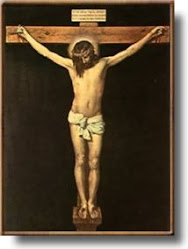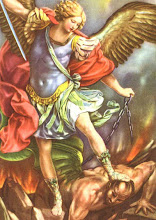About the movie “The Last Temptation of Christ”
(From the Byzantine Icon to the TV Set)
The Holy Scripture does not give us any detail concerning the aspect of Jesus. This fact gave birth to some controversial theories concerning the historic aspect of the Saviour. The truth about the aspect of God preoccupied the minds of the Christians immediately after the epoch of those who were eyewitnesses. The reason for which the aspect of the Saviour did not spread among the first Christians arises from the very essence of Christianity, from the high philosophical principles concentrated around the spiritual world and not around the material one. That is why the material aspect of Christ was replaced very easily by symbols, for example the fish (made of stone or of amber and hung by Christians at their neck in the same way we do today with the cross), and had no impediment upon their belief in Him. The first Christians, because they were waiting for the second coming of the Saviour (which they considered to be immediate) focused more on the spiritual side, that is the facts which concerned more their own Salvation and paid less attention to external details, for example the physical aspect of the Saviour. Certainly, this situation changed in time. Due to the fact that very few people could reach the high Christian philosophy, and the fame of the Wiseman from Nazareth surpassed the boundaries of His people spreading among the pagans, some images of the Saviour began to appear as each people could imagine Him. For instance, the Romans represented Christ as a soldier carrying a sheep upon His back (The Kind Sheppard, Roman catacombs, centuries II-III), while the Greeks represented Him as a beardless young man, bearing in mind the model of Hermes. In one word, the cult of the human body cultivated by the Greeks, the pagan anthropocentricism reflects inevitably upon the painted representations of Christ. It is against this fact that the fathers of the Vth–VIth Ecumenical Synod (692) rise and interdict categorically all images by means of the rule 100, images which “…put spells upon the eyes, corrupt the mind and create explosions of devilish pleasures”. That is why, the Byzantine style of canonic representation has been established to represent the Saviour, His Mother and all the Saints and is present even today in Orthodox churches. Serious and essential, the Byzantine style catches the state of the deified, spiritual body lacking any allusion to human body; this is the new body about which Apostle Paul speaks. This canon was violated in the western countries where a soppy, even perverse painting has been developed since the Renaissance and until nowadays. But which is, in fact, the truth about the image of God because since He had a human body and lived among us, it is clear that He had a historic countenance, which He appeared with. Let’s see what the Christian philosopher Origenes says in his work “Against Celsius”, written in the year 248 where he quotes Celsius: “If the Spirit of God embodied truly in him (Jesus), then he must distinguish himself from the other ones by the beauty of his face, by the perfection of his body, as well as by the art of speaking. Because one can’t believe that the one in whose body was something of divine origin can’t distinguish himself from the other ones. And still people say that Jesus had a miserable body and a face so ugly that it provoked abhorrence”. 1 The opinion about un unpleasant aspect of the Saviour belonged to the early Christian theologies (Tertulianus, Saints Clement and Cyril of Alexandria, Saint Irineus of Lyon, and others) and it was based on the literally understanding of one of prophet Isaiah’s verses referring to the embodiment of God: “He had neither a pleasant face, nor beauty so that we could admire Him and no pleasant aspect to care for Him. He was despised even by the last man of no importance” (Is. 53, 2-3). However, we incline to joint the parents who find in this verse the direct indication to Saviour’s passions. In this respect, the description, which is clearly repellant, does not influence the conception about the physical perfection of Christ. In fact, imperfection itself is a consequence of the falling. Because “God created the man according to His own image” (Creation, 1, 27) “ and God realized it was good” (Creation, 1, 12-18-21-25). So, creating Adam, God made him perfect and only sin could generate all the later imperfections, even the physical ones, as stigmata of “his death” (Creation, 3, 3) and as a violation of the command of God. Yet “the holiness of the body of our God and Saviour was infinitely greater than the holiness in which the being’s body was created – the body of Adam”. 2 Any physical imperfection, in this case, in the description of our Saviour, would come in contradiction with the lack of sin, which is said to characterize Him. Christ’s physical perfection is the guarantee for the success of the renewal of the old Adam by the new Adam – our God.
Starting from the same fact - that of deifying of Christ as noted by Origenes, Saint Ignatie Brancianinov writes: 3 “ The body of the God-man had a strange grace and beauty, exactly as His proto-father and prophet David sang about Him: Adorned with beauty art Thou more than the sons of men (Psalm 44, 2). But the physical beauty of the God-man had not the same effect upon women, as usually does the beauty of men6. Such a blasphemy must be rejected although it is pronounced and accepted by heretics.7 On the contrary, the body of Christ healed all the passions – both of the body and of the soul. His body was impregnated with divine grace and spread it all around to those who touched Him, both men and women. Great power went out of Him – says the Gospel – and healed everybody.(Luke, 6,19). And all those who touched Him were healed. (Mark, 6, 56). This is that divine body about which God Himself stated: The one who eats My body and drinks My blood will live forever and I will raise him from the dead in the Last Day. (In.6, 54-56). Saint Joannnis Chrisostomus is of the same opinion when he states that “Jesus was a very beautiful man”; together with Saint Gregory of Nyssa, Blessed Augustine, Saint Ambrosias of Mediolania they were convinced that the God- man “adorned Himself with beauty more than the sons of men”; “ Thy lips were covered with holy grace and this is why Thou art blessed by God.” (Psalm 44, 3).
But the stage director Martin Scorsese considers this problem in a very different way in his movie “The Last Temptation of Christ” (made after Nikos Kazantzakis’s book). 8 For him, Jesus Christ is not the Chosen One. Not only that He equals everybody, but also He is completely trite, He is more than ordinary. His face lacks any trace of the divine grace and is physically repulsive. His face is full of platitude, exactly as His life is. In His discussion with Judah He states that one needs to free his soul because if one does not so, the chain of evil will never be broken, that the main purpose is the salvation of the soul and not the liberation from the Roman oppression or the salvation of the body, as Judah states. All these do not convince the spectator through the metaphorical solutions given to the events, especially the crucifixion, which abounds in purely physiological elements and in the sufferance of Jesus crucified. He dies physically on the Cross and one can’t believe His spirit will ever reach at His Father.”9 The impression made by Scorsese’s movie is not even this base philosophy but something even scarier. The idea that Christ was not God is found in Gospels at the God-killing Jews and that is why they crucified Him. “We found this man rebelling our people and saying He is Christ”(Luke, 23, 2). The idea that Jesus was born in fornication and that He was demonized is also present in Gospels at the same mad Jews (Mark, 3, 22; John, 8, 41). Scorsese goes further and presents on the screen the filthy gossips created around our Saviour and Mary Magdalene.
In fact, this subject preoccupied not only Scorsese. The Spanish writer Jose Saramago publishes a novel with the same subject “The Gospel after Jesus” (immediately translated into Russian) for which he was awarded with the 1997 Nobel Prize for literature. The Romanian yogis who imported it for their western colleagues discussed this subject. The yogis, especially the western ones, try to motivate their orgies not only by the means of their deities as Krishna (who had 16,800 goppy-sheperdesses) but also by ascribing such lying “qualities” to our saints and even to our Saviour Jesus Christ (we are aware of the speculations made by the resemblance of the words Krishna and Christ). They like to discuss not only on the case of Mary the Egyptian and of Mary Magdalene but also on some other examples taken from the Patristic Texts in which are presented the fallings of some monks followed by their repentance and reformation.
The yogis even found the phrase from the Gospel in which Jesus “praises” fornication: “Her multitude of sins is forgiven because she loved a lot” (Luke, 7, 47). Considering their clever minds, “she loved a lot” refers to the fact that she loved lots of men. As I discussed more than half a day with one of these yogis, a person who pretends to be a writer and I could not convince him by the contrary, I dare to make things clear. If Jesus praised Mary Magdalene for the fact that “she loved lots of men” as yogis pretend, why did Mary Magdalene (who loved Jesus sincerely till the end of her life) gave up fornication, if He praised her for doing this? Where do we know she gave up fornication from? From her crying and tears. For what reason such a famous woman as she was at that time, came and humiliated herself in front of all the others? Because she spread His words together with the Apostles till the end of her life and because she was the first person to whom Jesus revealed Himself after Resurrection (John 20, 14-16). The trouble with this movie is not its subject because it belongs to an unbeliever, but the fact that it was presented in an orthodox country. Nowhere in the world can one present an anti-Semitic movie without being followed by repercussions, especially in Israel.
Never the Istanbul Television will present a movie in which prophet Muhammad is mocked at. While in India, no one dares to drive away a cow from the autoroute because it is considered to be saint! The same movie was presented in Russia in 1997. This is the opinion of the famous theologian, with a doctorate in philosophy, maybe the most famous apologist of contemporary Russia, deacon Andrei Kuraev: “the most outrageous event of the religious life of Russia of the year 1997 happened on November 9th. On this Sunday evening the NTV presented the movie “The Last Temptation of Christ”. The hidden conflict between the huge informational kingdom of Russia and the Orthodox Church broke out, the former declaring war on the latter.”11 The Church gave no occasion for this. The calendar was the only reason: November the 9th, the celebration of the Crystal Night. This is the sad night when persecutions on Jews began in the Nazi Germany. It is understood that the main director of the NTV, Alexandr Faifman as well as its owner, Mr. Gusinski (general director of “media-MOST” and president of the Russian Jewish Congress) keep in mind a painful recollection of this night. But why he decided to revenge upon the Russian orthodox believers for the crime of the German neo-pagans (it is already known that Nazism, nourished by occultism, was an enemy not only for Judaism but also for Christianity)? Why this pain of him flooded as an insult upon that people who saved the European Jewish Community from annihilation?
No insults? Was it only the right of every person the express freely his own opinion? Yes, there is such a right, within its natural limits. The free movement of my hand ends exactly where the face of another person begins. The other one’s pain – this is the border upon which not even the most legitimate sentiments of mine can pass. Neither my joy, nor my sorrow must provoke other people’s pain (…)
Yes, every person has the right do discuss with Christians, the right to criticize and to contradict. But he has no right to spit and to utter blasphemies. It is a blasphemy to stamp upon one’s memory bed scenes between Mary Magdalene and… And there are the explanations: “Look, this fact is intended, these are hallucinations created by the Devil in the consciousness of the Crucified”, explanations which have no importance. According to Christian knowledge, in general, bad and lying thoughts cannot appear in the consciousness of the God-man Christ. The voice of the King of Darkness cannot sound within the Son of God. But his movie is a blasphemy not only from the point of view of the believer. A massive anti-cultural movement promotes an intentional blasphemous reading of The Gospel. Thirst for mockery, for defiling, everything is saint, characterizes the contemporary nobility. Pushkine becomes interesting not by his poetry but by his “Don Juan list”; they remember Chaikovsky especially when talking about sexual minorities…”12 The fight of the Church against such sub-productions is not the fight of some fanatic persons against cultural progress but an impulse to direct towards the true culture. An impulse to discover and make known the profoundness of the human spirit that is not proper to animals, that is to make us aware of the immortality of our human soul, of the high philosophy we are summoned to understand. In this specific case, there is not a simple violation of religious intimacy of Christians, but a distortion of reality and a pathologic alienation from the minimum intellectual stability, which is necessary to each person.
The movie “The Last Temptation of Christ” was rejected not only by the believers but also by non-believers, because it is full of improper realism, but not of realism, widely speaking. In the Orthodox theology there is a concept as “religious mystical realism” (Pavel Florenski, Leonid Uspenski, and others) whose essence lays in the fact that iconography when creating “the unimaginable face” (or “the incomparable resemblance”) reflects the supreme deifying reality. And that is why the religious symbol is much more realistic than the illusory imitation of life in realistic painting. The symbol does not oppose to realism, but to the abstract imagination, which declines any relationship with reality, except that with itself.13 That is why the canonic representation of Christ in orthodox iconography is the closest to His historical and mystical reality and only the spiritual immaturity of some persons led to the decay of the icon in its Renaissance and Roman-catholic variant. In this respect it is very easy to follow the spiritual state of a certain people end epoch, considering the way of thinking the icon, the seeing face of the unseen. With the movie “The Last Temptation of Christ”, mankind touches the climax of moral and spiritual regression. What God did in the beginning “according to His face and resemblance”, does no longer exist. Now it is the man who creates God according to his face and rotten resemblance (Romans 1, 23).
And if through the means of “the seventh art” – the movie, painting surpassed itself (and we are entitled to call the movie a living painting), more than the essay of the Ancients to stop the time, that helpless sigh of Goethe: “Stop, oh, moment: how wonderful you are!” then the movie “The Last Temptation of Christ” is the unavoidable sequel of a not respected iconographic canon from the year 692.14 The lack of obedience of the Roman- Catholics as well the practice of painting catalyzed by the feelings of the decayed nature, developed together with the extension of painting within the film art, towards the serious accents which result from this movie.
CHRISTIAN RELIGION ARTICLES
domenica 6 gennaio 2008
Iscriviti a:
Commenti sul post (Atom)



































Nessun commento:
Posta un commento